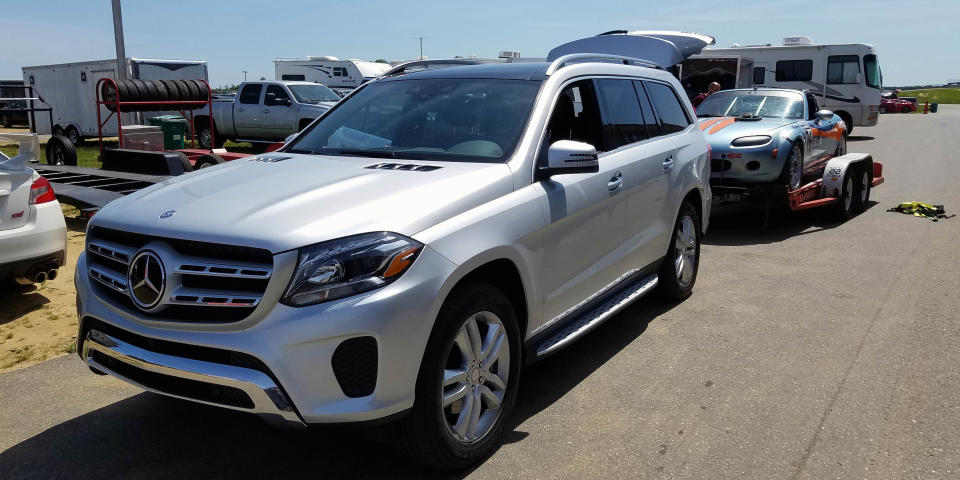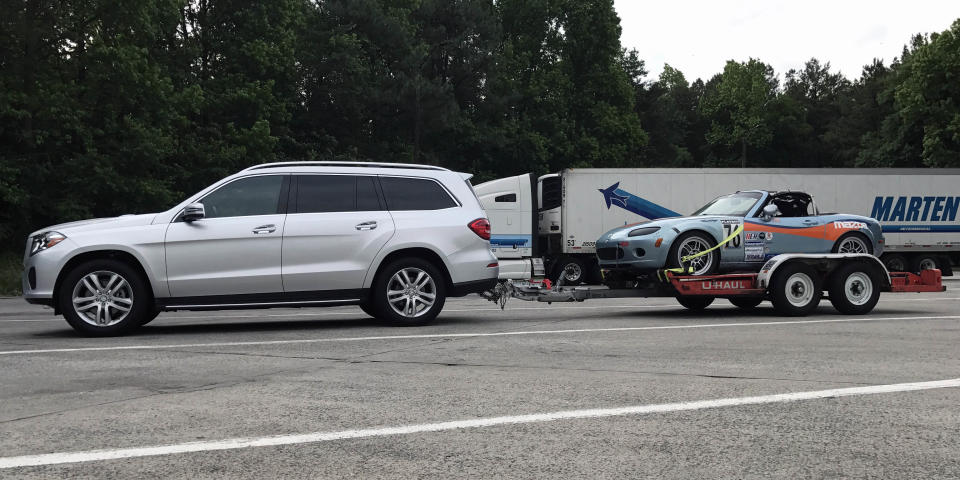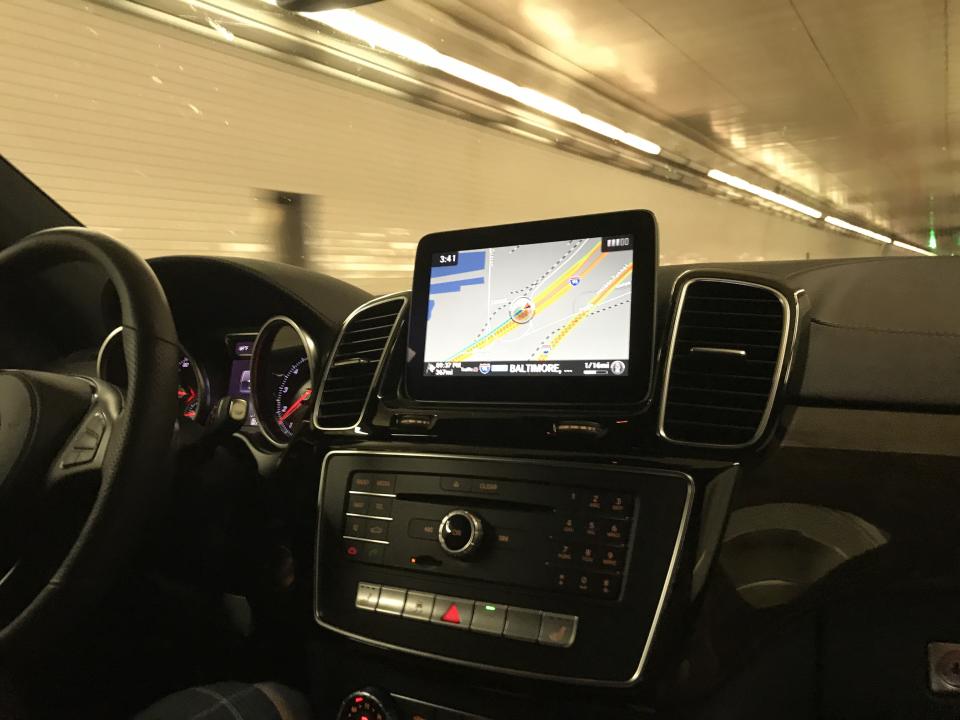Mercedes-Benz GLS450: Towing Test

Segment-buster. It’s an auto-industry term for any time somebody comes up with a kind of car that didn’t quite exist before. The Renault Espace and Plymouth Voyager were segment-busters because nobody had done a FWD minivan before. Toyota’s RAV4 was a segment-buster, too, as was the PT Cruiser. Automakers spend immense time and money trying to create the next one because there’s nothing quite as profitable as having an effective monopoly on a popular new product.
So let me introduce you to a segment-buster that’s been hiding in plain sight for quite some time. The Mercedes-Benz GLS450 is, nominally speaking, a full-sized SUV, competing heads-up with the Titanosaurs from General Motors, Ford, Toyota, and Nissan. There’s just one not-so-little difference. Whereas the Escalade, Expedition, Armada, Sequoia, and Land Cruiser are all body-on-frame monsters derived from full-sized pickups or African-oriented workhorses, the GLS and its GL-Class predecessors are unibody products scaled up from the GLE/M-Class SUV. The M-Class ditched its frame with the arrival of the second-generation truck a decade ago and was much better for having done so.
The detail-oriented among our readers will point out that the current Range Rover is also a unibody vehicle, but the Range Rover is a very different, and considerably more expensive, proposition. The GLS450 starts at less than seventy grand with a reasonable complement of standard equipment, it offers cargo space and interior comfort that is very competitive with the big domestic SUVs, and it can supposedly tow 7,500 pounds without difficulty.

We decided to test the towing credentials of the big Benz with a long haul from High Point, NC to New Jersey Motorsports Park, where the Road & Track And Friends MX-5 Cup car would be competing in a double endurance race weekend. The trailer was a standard-issue car carrier from U-Haul. It was in fairly rough shape–our team fueler and loadmaster, Bojan, actually gasped when he saw it for the first time–and at some point during the weekend the inertia-based hydraulic brake that is fitted on most of these old U-Haul rigs decided to vent all of its brake fluid to the road. So while the total weight of the trailer and the car probably wasn’t much past 5,000 pounds, pulling it presented a bit of a challenge for all involved.
Much advertising and editorial copy is written about how the trucks from the Big Three have absolutely mastered every aspect of recreational towing, but the moment we started up the big Benz with the trailer plugged in we saw something that earned our immediate respect. The GLS450 can warn the driver that the a particular light is not functioning on the trailer, which was the case here. And it also disables the lane-keeping feature by default. That’s a common-sense decision that unfortunately is not the case with some of the competition and can lead to some troubling moments when the lane-keep decides to start an unwanted trailer oscillation.
On the other hand, the laser cruise control continues to work when towing, and while it’s probably not a great idea to use cruise control with a trailer it’s also something that pretty much every club racer out there does during those long overnight pulls to the track. The GLS maintains a gap that would be ridiculous in something like a 911 Turbo but which in a six-ton combination of truck and trailer is perfectly fine.

There was once a time where the idea of towing anything with a turbo V6 would have seemed ridiculous but we are now in the era of the EcoBoost F-150 and this Mercedes can match it stride for stride. With 362 horsepower, the GLS450 cracks off low fourteen-second quarter-miles unladen. It never felt underpowered during our 1,300 miles of towing; not in Philadelphia-area traffic, not on long grades, not when pulling out to pass semi-trailers. The new 9G-Tronic automatic goes a long way towards making sure the engine is always making boost when you need it, and while it’s both possible and pleasant to shift manually using the wheel-mounted paddles you don’t really need to.
The brakes, too, are more than up to the task, never vibrating or fading even after the trailer hydraulics had called it a day. The pedal stays high and the travel stays short, even in the heat of a Jersey summer. Without the car-hauler attached, the GLS stops short in an even bigger hurry. The artificial feel and worrisome “pedal sink” that used to plague electronically-adjusted Benz brakes has been thoroughly exorcised, thankfully.
Despite maintaining a fairly ambitious pace for our trips both to and from New Jersey, we recorded better than 15MPG for the entire tow, which is almost exactly what my wife’s 5.3-liter Tahoe manages when it’s towing nothing at all. If you want to be able to beat a 1984 Corvette down a dragstrip by a lot rather than a little, M-B offers both a GLS550 and a GLS63, but those are priced to compete with the Range Rovers while this six-cylinder variant is closer to a Tahoe Premier or Yukon Denali.

Not that the driving experience is comparable to any of the above-mentioned SUVs. The GLS is very much the 'sports car' of this category, aided and abetted by a relatively narrow-feeling cabin, not much visibility of the bonnet ahead, and a seating position that is not that far from what you’d get in a Mercedes sedan. The feeling of supercarrier width that is part of parcel of Escalade or even Land Cruiser ownership doesn’t apply here. It’s not cramped, not even for larger-than-normal drivers and passengers. It’s just different. I will confess that I was a little disconcerted by the relatively intimate cabin at first because I’ve come to associate towing capability with massive dashboard width and oversized fittings–think Super Duty. But the GLS doesn’t have, nor does it require, that sense of tractor-trailer theater.
If long-time Stuttgart loyalists are put off by the fact that this is a full-sized SUV made in the United States, perhaps they will be slightly mollified by the standard fitment of M-B Tex. You can have leather for the low, low price of $1,610. but anybody who wants to tow or haul with their GLS should save their money and enjoy the finest seating material known to man. It doesn’t stain, it wipes off clean, and it will probably last until the heat death of the sun. More than any other single feature of this or any other Mercedes-Benz, the M-B Tex upholstery exemplifies the cardinal brand virtues of excellence, durability, and fitness for purpose that made cars like the old W123 sedans justly famous.
Don’t be surprised if the GLS450 ends up earning a similarly respectable reputation in years to come. As a Benz bigot of the old school with a Cosworth 190E in my past, I should be roundly dismissive of what is clearly a sop to the crass, bigger-is-better, SUV-obsessed American market. I recall being utterly horrified by the original ML320, which looked to me like a Euro-market A-class hatch that had been made out of recycled bottles and left to bloat in the sun. But the truth is that the GLS450 offers pretty much everything you’d want out of a proper Mercedes sedan, combined with pretty much everything you’d want out of a towing-focused full-size SUV. It’s the kind of vehicle that grows on you with every passing mile as you become conscious of all the intelligent little decisions and choices made in its design and engineering.

What’s left to say? Cargo room is outstanding, aided and abetted by the low load floor and easy-fold seats. Visibility is excellent to all sides, with almost no blind spot. The Mercedes-Benz cruise and wiper stalks continue to be the standard by which every other system should be judged. The stereo is better than good. The rear view camera is positioned in such as way as to allow you to connect a trailer without assistance, the same way it is in the better full-sized trucks.
We won our class in Saturday’s race but bowed out early with a clutch problem on Sunday. The GLS450 made short work of the trip home, no easy task for a team that had stayed awake for most of the two previous nights working on the race car. Spacious, swift, and nearly silent, the big Benz was far better than expected. Compared to its competition, it is easier and more pleasant to drive, uniquely relaxing over long distances, and absolutely competent at pulling an uncooperative load. In other words, it’s a sort of secret segment buster, and one that probably won’t stay a secret forever.
You Might Also Like

 Yahoo Autos
Yahoo Autos 